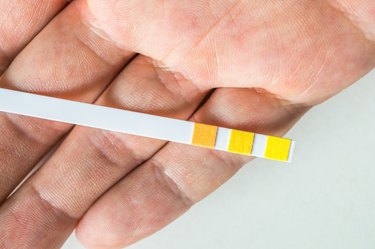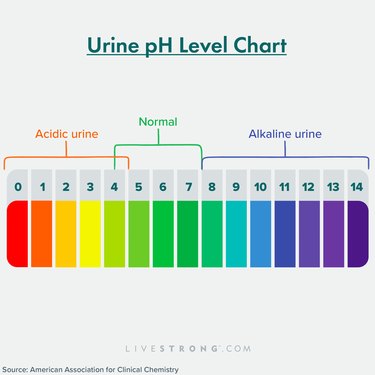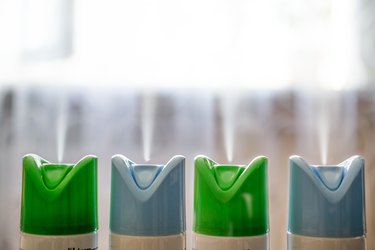
The pH of your pee is simply a measure of how much (or how little) acid you have in your urine. While most people have normal urine pH, abnormal levels can be caused by something as simple as what you just ate, or they could mean you have a medical condition or are at risk for one.
Here's more about what causes low and high urine pH levels and why it matters.
Video of the Day
Video of the Day
What Is a Normal Urine pH Level?
One of the kidneys' most important roles is to filter out acidic or alkaline components through the urine in order to keep blood pH levels within a tightly controlled range, explains Naveen Kachroo, MD, PhD, a urologist with Henry Ford Health System in Detroit. Normal blood pH levels are critical for your health.
Normal urine pH fluctuates from 4.6 to 8, which leaves plenty of room for your kidneys to offload acidic or alkaline components as needed, adds Alec Saitman, PhD, technical director of the core laboratory at Providence Regional Laboratories in Portland, Oregon.
The pH scale goes from 0 to 14, with lower numbers being more acidic and higher numbers being more alkaline or basic. Seven is neutral, per Merck Manual.
With that in mind, here are the pH numbers to know:
- Acidic urine: Below 5
- Normal: 4.6 to 8
- Alkaline urine: Higher than 8

How Diet Affects pH Levels
Diet is one of the most common things to affect urine pH, Dr. Kachroo says.
Animal-based foods like meat and cheese tend to cause high-acidic urine. Even some carbonated beverages can contribute, says Melissa Ann Prest, RDN, a registered dietitian nutritionist and national spokesperson for the Academy of Nutrition and Dietetics.
"Fruits, vegetables, whole grains and healthy fats can help to balance out a diet of mixed acidity," adds Prest, who recommends apples, pineapples, blueberries, cabbage, bananas, grapes, zucchini, arugula, beets, cucumbers and spinach.
Chestnuts, macadamia nuts and pumpkin seeds can help lower urine acidity, too, as can avocados and olive oil.
In general swapping out animal proteins with plant proteins like beans, legumes and tofu can also help to reduce the acidity of urine, Prest says.
Related Reading
What Urine pH Says About Your Health
Too-high or too-low urine pH levels could indicate the presence of a medical condition, or a higher risk for one.
1. Kidney Stones
Kidney stones are at the very top of the list. Very acidic urine can raise the risk of uric acid, cystine and calcium oxalate kidney stones (one of the most common types), while very alkaline urine can raise the risk for struvite and calcium phosphate stones, Dr. Kachroo says.
If you have a tendency to form uric acid stones, your doctor may take steps (including changing your diet and/or medications) to make your urine more alkaline. The opposite would be true for struvite and calcium phosphate stones.
2. Metabolic Acidosis or Ketoacidosis
Low pH levels indicating more acid in your urine could also mean you have metabolic acidosis or ketoacidosis, Dr. Saitman says.
Metabolic acidosis is an acid build-up caused by kidney disease or kidney failure. Diabetic ketoacidosis happens when your liver starts to break down fat for energy, producing acid-high substances called ketones.
3. Other Factors
Other things that can cause alkaline or high pH urine include:
- Urinary tract infections
- Vomiting
Other factors that can cause acidic urine include:
- Diarrhea (which depletes electrolytes)
- Starvation
How Urine pH Tests Work
Health care providers usually only check urine pH as part of a broader urinalysis, which also scans for issues like infections, Dr. Saitman says. While urine tests are a routine part of exams when you see a urologist, they're not typically part of a regular physical exam.
Knowing your urine pH level could help diagnose a condition (often along with other markers), and it can help monitor how effective strategies like diet and medication are for lowering or raising levels. "It will look at trends," says Dr. Kachroo.
The procedure for a urinalysis is simple and painless. You simply urinate into a sterile container. A provider then inserts a dipstick into the sample (much like a pregnancy test). The dipstick changes color depending on how acidic or alkaline your urine is.
You may need to stop taking certain medications that can affect urine pH before doing a urinalysis. These include
- Acetazolamide (to treat glaucoma and other conditions)
- Ammonium chloride (for metabolic alkalosis)
- Methenamine mandelate (an antibiotic used to treat UTIs)
- Potassium citrate (for certain types of kidney stone)
- Sodium bicarbonate (for heartburn, acid indigestion)
- Thiazide diuretic (for hypertension)
What About Home Tests?
It's much easier to collect urine at home than it is to collect blood, which is probably why there are so many home urine tests available over-the-counter.
Most of them have little or no clinical value, says Dr. Saitman. "I love the idea that patients are taking control of their own health, but if they test themselves without the background to understand what that testing may or may not mean," it doesn't do much good.
Take urinary tract infections, for instance, which many home tests are marketed for. While the test may (sometimes) determine you have an infection, it won't necessarily tell you what kind or how to treat it, cautions Dr. Kachroo. For that, you'll need a health care professional.
The other problem with home tests? The Food and Drug Administration doesn't regulate them the same way as drugs, so you can't be certain that a test you find online or on a pharmacy shelf will give you accurate results.
- UCSF Health: “Urine pH test”
- Merck Manual: “Overview of Acid-Base Balance”
- National Kidney Foundation: “What is a Plant-Based Diet, and Is It Good For Your Kidneys?
- National Kidney Foundation: “Metabolic Acidosis”
- Centers for Disease Control and Prevention: “Diabetic Ketoacidosis”
- American Association of Clinical Chemistry: “Urinalysis”
- National Library of Medicine: “Acetazolamide”
- Memorial Sloan Kettering Cancer Center: “Ammonium Chloride”
- National Library of Medicine: “METHENAMINE MANDELATE tablet”
- Mayo Clinic: “Potassium Citrate (Oral Route)”
- Mayo Clinic: “Sodium Bicarbonate (Oral Route, Intravenous Route, Subcutaneous Route”
- StatPearls: “Thiazide diuretics”
- Food and Drug Administration: “OTC - Over The Counter”
Is this an emergency? If you are experiencing serious medical symptoms, please see the National Library of Medicine’s list of signs you need emergency medical attention or call 911.


